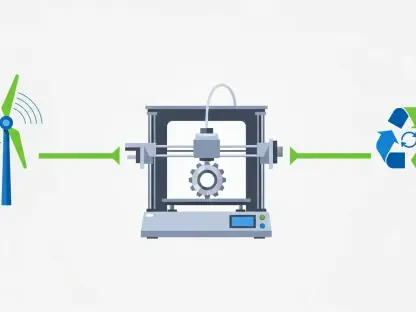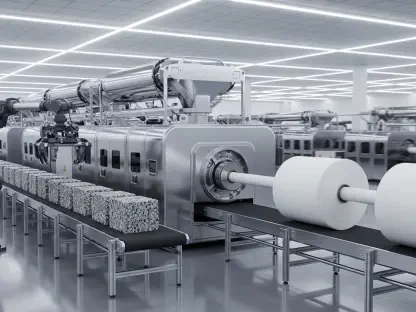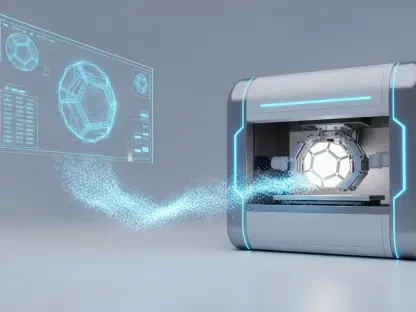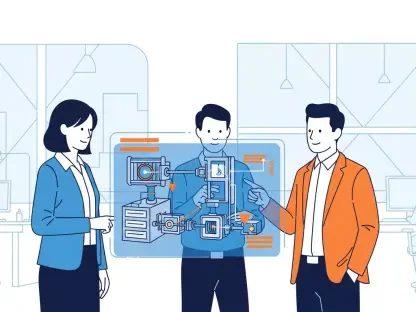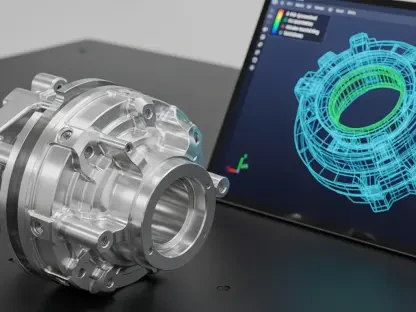The manufacturing industry is undergoing a significant transformation, driven by technological advances and a growing emphasis on sustainability. Modern technologies and strategic methodologies are shaping the future of manufacturing, making it more efficient, sustainable, and resilient. This article explores the impact of these innovations and their contribution to the industry’s evolution.
Embracing Technological Integration and Digitalization
The Role of Artificial Intelligence of Things (AIoT)
Artificial Intelligence of Things (AIoT) combines the best of AI and IoT to enhance manufacturing processes where production lines are more nimble and responsive. By leveraging AIoT, manufacturers can achieve heightened levels of productivity by analyzing vast amounts of data and providing actionable insights. The integration of AI and IoT allows for real-time monitoring and autonomous adjustments, resulting in optimized workflows, reduced operational costs, and enhanced safety measures. This synergy gives rise to more intelligent manufacturing systems capable of self-diagnosis and adaptation.
AIoT does not just stop at improving existing processes; it opens the door for groundbreaking advancements. For example, the intelligent detection of maintenance needs before they become critical ensures that equipment remains in optimal condition. This significantly reduces the likelihood of unexpected downtimes, allowing for a seamless production environment. AIoT also brings predictive capabilities that are otherwise unattainable, thus setting a new standard for operational efficiency in manufacturing. With AIoT, manufacturers are not only reaping immediate benefits but also laying the groundwork for further innovations.
Predictive Maintenance with AI
Predictive maintenance powered by AI represents another leap in efficiency, showcasing the transformative potential of machine learning and data analytics in maintaining machinery. By predicting equipment failures before they occur, manufacturers can preempt costly downtimes and extend the life of their machinery. AI-driven systems utilize sensors and advanced algorithms to monitor equipment conditions and predict possible failures. For instance, thermal imaging combined with machine learning algorithms can identify overheating components or unusual patterns that human operators might miss, ensuring continuous, smooth operations. This preemptive approach to maintenance translates into lower repair costs and increased operational uptime.
Moreover, predictive maintenance fosters a proactive mindset among manufacturers. By relying on AI-driven insights, maintenance teams can schedule repairs during non-peak hours, minimizing disruption to production schedules. The accuracy of predictions continually improves as AI algorithms learn from historical data, making maintenance regimes more efficient over time. This advanced capability to foresee potential issues brings an added layer of security and reliability to manufacturing processes. As predictive maintenance becomes an industry standard, it underscores the critical role AI plays in enhancing the longevity and efficiency of manufacturing equipment.
Pushing Toward Sustainability
Decarbonizing Through Smart Building Technologies
Sustainability is no longer optional but essential in contemporary manufacturing, and smart building technologies are spearheading these decarbonization efforts. The adoption of these technologies plays a pivotal role in reducing energy consumption and minimizing carbon footprints. Smart sensors and automated systems allow factories to manage energy use more efficiently, ensuring that production facilities operate at optimal levels with minimal environmental impact. This intelligent energy management helps industries shift towards a circular economy model with reduced waste and improved resource utilization.
These technologies extend beyond simple energy management to incorporate various aspects of sustainable manufacturing. For instance, smart buildings can integrate renewable energy sources such as solar panels and wind turbines, further decreasing reliance on nonrenewable energy. Real-time data collected from various sensors can also provide insights into how to further reduce emissions and improve air quality within manufacturing facilities. As industries increasingly adopt these technologies, they are taking concrete steps toward achieving their sustainability goals, thereby playing their part in mitigating climate change.
Moving Towards Zero Waste
The concept of zero waste to landfill is becoming the new standard for many manufacturers who aim to align with global sustainability goals. By integrating advanced waste management systems with manufacturing processes, companies are successfully minimizing waste generation and maximizing resource efficiency. This concerted effort towards reducing landfill waste involves recycling, reusing, and repurposing materials to ensure that as little as possible is wasted. Manufacturers are adopting closed-loop systems where byproducts are reintegrated into the production cycle, thereby conserving natural resources and minimizing environmental impact.
Moreover, implementing zero waste practices has substantial economic benefits. Companies that focus on waste reduction often find that they save money in the long run by reducing raw material costs and waste disposal fees. In addition, a commitment to zero waste can enhance a company’s reputation and attract eco-conscious consumers. This aligns with the broader industry trend of adopting sustainable practices not just as a regulatory requirement but as a business imperative. By continually pushing the boundaries of what is possible in waste reduction, manufacturers are setting a powerful example of environmental stewardship for other industries to follow.
Future-Proofing Against Challenges
Building Resilience in Uncertain Times
Manufacturing businesses are no strangers to challenges, from geopolitical shifts to regulatory changes, and preparing for these uncertainties is crucial. To navigate these unpredictable conditions effectively, manufacturing companies must prioritize resilience and agility. This involves adopting flexible business models that can quickly adapt to changing circumstances. For instance, investing in diversified supply chains can mitigate the risks associated with geopolitical tensions. Additionally, fostering a culture of adaptability among employees ensures that the workforce is prepared to tackle new challenges as they arise.
Risk management is another critical component of building resilience. By conducting thorough risk assessments and developing comprehensive contingency plans, manufacturers can be better prepared for a range of potential disruptions. This proactive approach allows companies to maintain operations even during crises, minimizing losses and ensuring business continuity. The importance of resilience is magnified in an increasingly volatile global market, and manufacturers who prioritize this attribute will be better positioned to thrive in the long term. Building resilience is not just about surviving challenges but also about seizing opportunities that come with change.
Preparing for Regulatory Changes Post-2024 Election
The political landscape can have profound impacts on manufacturing, and with potential changes in trade policies, taxes, and regulations post-2024 U.S. presidential election, manufacturers are wise to remain vigilant and proactive. Staying informed about upcoming policy developments is essential for making strategic business decisions. Manufacturing companies must engage in ongoing dialogue with policymakers to advocate for favorable conditions that support industry growth and innovation. Lobbying efforts can ensure that the voices of manufacturers are heard, influencing policies in ways that benefit the industry.
Manufacturers should also consider diversifying their markets and supply chains to mitigate risks associated with political shifts. By expanding into new markets or sourcing materials from multiple suppliers, companies can reduce their dependency on any single region. This strategic diversification can provide a buffer against potential regulatory changes that might otherwise disrupt operations. Additionally, investing in compliance programs ensures that companies are prepared to meet new regulatory requirements swiftly and efficiently. The ability to adapt to regulatory changes is a crucial component of resilience, helping manufacturers navigate the complexities of evolving political landscapes.
Fostering Innovation and Collaboration
Industry-Academic Partnerships
Innovation thrives on collaboration, and partnerships between industry and academia are crucial for advancing manufacturing technologies. These collaborations bring together the theoretical expertise of academia and the practical experience of the industry to drive innovation forward. Initiatives like the NVIDIA AI technology centers at Carnegie Mellon University and the University of Pittsburgh exemplify the power of such partnerships. These centers are dedicated to researching and developing new AI applications tailored for manufacturing, paving the way for groundbreaking advancements.
These collaborative efforts are particularly valuable in addressing complex challenges that a single entity might struggle to overcome. By pooling resources and expertise, industry-academic partnerships can accelerate the development of innovative solutions that benefit the entire manufacturing sector. Furthermore, these partnerships create opportunities for students and researchers to gain hands-on experience in real-world settings, preparing the next generation of innovators. As the manufacturing industry continues to evolve, the importance of fostering strong ties between academia and industry cannot be overstated.
The Role of Public-Private Collaborations
Public-private collaborations create a symbiotic relationship that accelerates innovation, ensuring that cutting-edge advancements are brought to market efficiently and effectively. Governments and private enterprises working together can achieve more than either could alone. For example, public funding can support research and development while private companies provide the practical application and commercialization of new technologies. This collaboration fosters an environment where innovation thrives, driving economic growth and technological advancement.
These partnerships also enable the rapid deployment of pilot projects that test new technologies in real-world scenarios. By working together, public and private entities can identify potential challenges and refine solutions before broader implementation. This collaborative approach reduces the risks associated with introducing new technologies and increases the likelihood of successful adoption. Moreover, public-private collaborations can help shape policies that support innovation, creating a regulatory environment conducive to technological advancement. As the manufacturing industry continues to face new challenges and opportunities, the role of public-private collaborations will remain crucial in driving progress.
Enhancing Operational Efficiency
Proactive Maintenance Strategies
Operational efficiency remains a key focus for manufacturers, and proactive maintenance strategies are essential in achieving this goal. Proactive maintenance involves regularly inspecting and maintaining equipment to prevent issues before they arise. Techniques such as thermal imaging can detect potential problems like overheating or wear and tear, allowing maintenance teams to address them before they lead to unscheduled downtimes. This approach ensures that equipment operates at optimal conditions, minimizing costly reactive maintenance and maximizing productivity.
The benefits of proactive maintenance extend beyond preventing equipment failures. By maintaining equipment regularly, manufacturers can extend the lifespan of their machinery, reducing the need for costly replacements. This not only saves money but also aligns with sustainability goals by minimizing waste. Additionally, proactive maintenance can improve workplace safety by ensuring that equipment is always in good working condition. For manufacturers, adopting proactive maintenance strategies is a wise investment that pays off in terms of both cost savings and operational efficiency.
Cloud-Based Solutions for Agility and Security
Cloud-based solutions, such as Electronic Data Interchange (EDI) and Enterprise Resource Planning (ERP) systems, offer unparalleled benefits in terms of agility, accuracy, and security. By shifting to the cloud, manufacturers can streamline operations, enhance data security, and maintain a competitive advantage in a dynamic market. Cloud-based EDI systems enable efficient communication and data exchange between trading partners, reducing errors and improving transaction speed. This agility is crucial for manufacturers operating in fast-paced environments where timely information is key to making informed decisions.
In addition to improving operational efficiency, cloud-based solutions offer robust security features that protect sensitive data from breaches. Cloud service providers invest heavily in security measures, ensuring that their clients’ data is safeguarded against cyber threats. This level of security is often beyond the capabilities of individual companies, making the cloud an attractive option for manufacturers. Furthermore, cloud-based ERP systems provide real-time access to critical business information, enabling manufacturers to monitor and manage their operations from anywhere. As technology continues to evolve, the adoption of cloud-based solutions will remain a vital strategy for maintaining efficiency and security in the manufacturing industry.
Addressing Industry-Specific Needs
Tailored Sales Enablement Solutions
Manufacturing-specific functionalities in sales enablement platforms like Salesforce are essential to address the industry’s unique challenges. These tailored solutions facilitate efficient workflows by integrating sales processes with manufacturing operations. For example, customized CRM systems can provide real-time updates on production schedules, inventory levels, and order statuses, enabling sales teams to make informed decisions and respond quickly to customer inquiries. This seamless integration ensures a smooth transition from order to production, improving overall customer satisfaction.
Tailored sales enablement solutions also offer advanced analytics that help manufacturers identify trends and opportunities in the market. By leveraging data-driven insights, manufacturers can fine-tune their sales strategies and optimize their product offerings to meet customer demands. Additionally, these solutions can automate routine tasks, freeing up sales teams to focus on building relationships and closing deals. As the manufacturing industry becomes increasingly complex, the need for customized sales enablement solutions will only grow, helping companies stay competitive and responsive to market changes.
Balancing Cost and Service Quality in ERP Systems
The manufacturing sector is currently experiencing a monumental shift due to rapid technological advancements and a heightened focus on sustainability. Cutting-edge technologies like automation, artificial intelligence, and the Internet of Things (IoT) are revolutionizing traditional manufacturing processes, resulting in greater efficiency and adaptability. Concurrently, there’s a significant move towards sustainable practices, including the use of renewable energy sources, reducing waste, and recycling materials. These innovations not only contribute to environmental preservation but also enhance the overall resilience and competitiveness of manufacturers.
Moreover, strategic methodologies such as lean manufacturing and just-in-time production are being increasingly adopted to streamline operations and minimize resource consumption. These approaches help companies respond quickly to market changes and consumer demands, ensuring that manufacturing remains robust and forward-thinking. These technological and methodological advancements are reshaping the manufacturing landscape, setting the stage for a more efficient, sustainable, and resilient industry poised for future growth.


